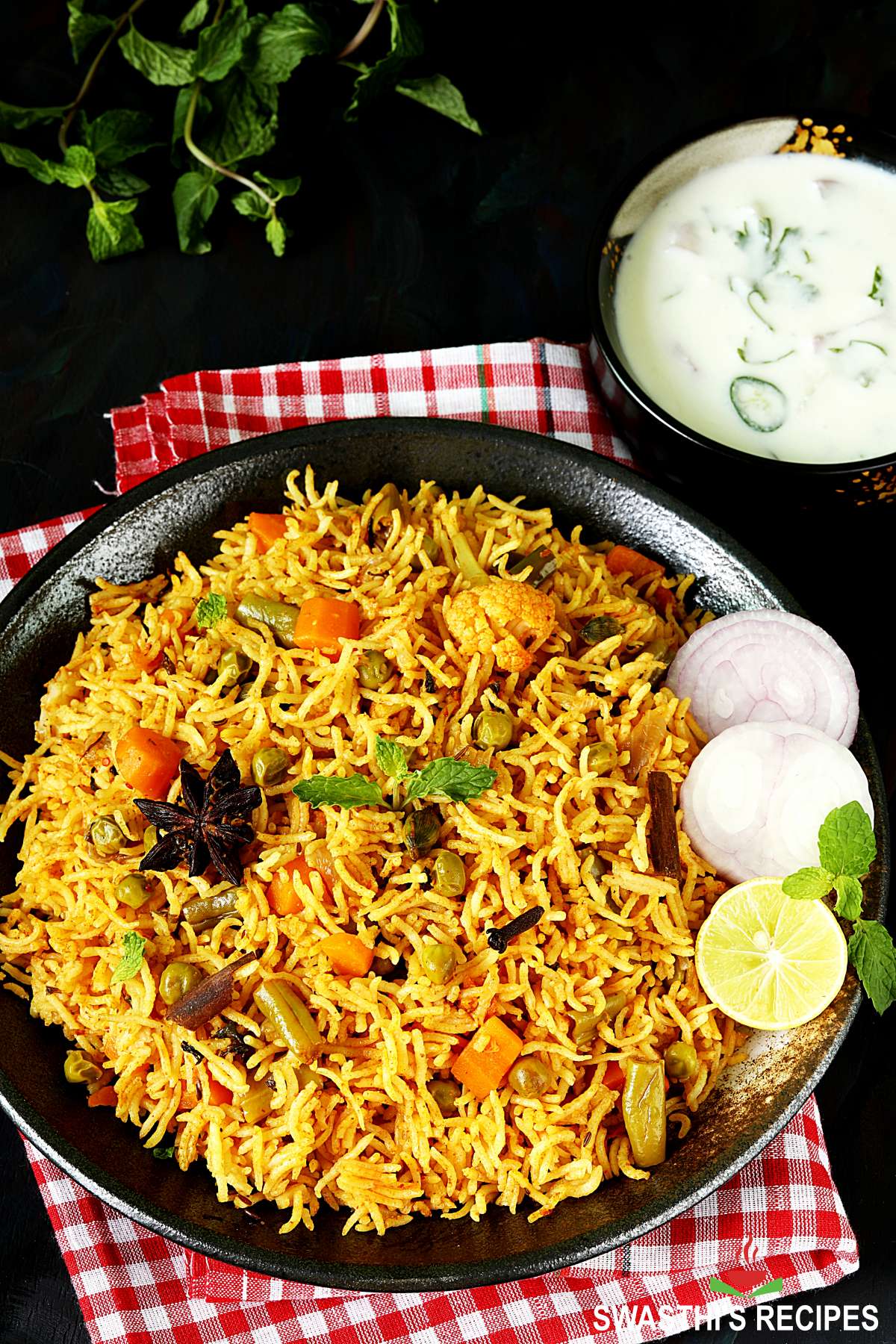
Introduction
Background And History Of Biryani
Biryani is a beloved rice and meat dish that originated in the Indian sub-continent. It is a celebratory dish often enjoyed on special occasions and gatherings. The traditional process of making Chicken Biryani involves marinating the meat in yogurt along with spices and herbs. The marinated meat is then layered with partially cooked rice and cooked together to perfection.
Benefits Of Preparing Biryani At Home
While Biryani is readily available at restaurants and takeout places, there are several advantages to preparing it at home:
- Customization: When making Biryani at home, you have the freedom to customize it according to your taste preferences. You can adjust the spice level, choose your preferred cut of meat, and add or omit any ingredients to suit your liking.
- Quality control: By preparing Biryani at home, you have control over the quality of ingredients used. You can choose fresh, high-quality spices, meat, and rice, ensuring a delicious and flavorful final dish.
- Healthier options: Homemade Biryani allows you to make healthier choices. You can use lean cuts of meat, control the amount of oil and salt used, and incorporate more vegetables for added nutrition.
- Cost-effective: Biryani can be an expensive dish when ordered from a restaurant. By making it at home, you can save money by using economical ingredients and making larger portions for multiple servings.
Here is a table comparing the advantages of preparing Biryani at home versus ordering it from a restaurant:
| Benefits | Homemade Biryani | Restaurant Biryani |
|---|---|---|
| Customization | Can be easily customized | Limited customization options |
| Quality control | Fresh and high-quality ingredients | Varying quality |
| Healthier options | Can choose healthier ingredients | May contain more oil and salt |
| Cost-effective | Economical ingredients and larger portions | Can be expensive |
In conclusion, preparing Chicken Biryani at home allows you to have control over the ingredients, customization, and cost. It also gives you the opportunity to create a healthier version of this classic dish. So why not try making Biryani at home and enjoy the aromatic flavors in the comfort of your own kitchen?
Types Of Biryani
Overview Of Different Types Of Biryani
Biryani is a versatile dish that comes in many different variations, each with its own unique flavors and cooking styles. Here are some of the most popular types of Biryani:
- Hyderabadi Biryani: This style of Biryani originated in the city of Hyderabad and is known for its rich and aromatic flavors. It is made with basmati rice, meat (usually chicken or goat), and a blend of spices such as saffron, cardamom, and cinnamon.
- Lucknowi Biryani: Also known as Awadhi Biryani, this variation hails from Lucknow, the capital city of Uttar Pradesh. It is known for its delicate flavors and is made with long-grain basmati rice, tender meat (usually chicken or mutton), and a combination of aromatic spices.
- Kolkata Biryani: This Biryani, which originated in Kolkata (formerly known as Calcutta), has a distinct sweet and tangy flavor. It is made with basmati rice, meat (usually chicken or mutton), and potatoes. It is also known for the addition of fragrant spices like nutmeg and mace.
- Sindhi Biryani: This Biryani variation comes from the Sindhi community in Pakistan. It is made with fragrant rice, meat (usually beef or mutton), and a blend of aromatic spices such as cumin, coriander, and cloves. It is often garnished with fried onions and served with raita.
Popular Variations And Regional Specialties
Apart from the above-mentioned types, there are many other regional specialties and variations of Biryani. Some of them include:
- Malabar Biryani: This Biryani is popular in the Malabar region of Kerala, India. It is known for its use of coconut milk, which gives it a creamy texture and subtle flavor.
- Chettinad Biryani: Originating from the Chettinad region of Tamil Nadu, this Biryani is made with a unique blend of spices called Chettinad masala. It is known for its spicy and robust flavors.
- Bombay Biryani: This Biryani, popular in the city of Mumbai (formerly known as Bombay), is a fusion of flavors from different regions. It is made with basmati rice, meat (usually chicken or mutton), and a blend of spices that includes ginger, garlic, and green chilies.
- Thalassery Biryani: This Biryani comes from the town of Thalassery in Kerala, India. It is made with a special variety of short-grain rice known as Jeerakasala rice and is flavored with ghee, spices, and fried onions.
Each type of Biryani has its own unique combination of flavors and cooking techniques, making it a delight to explore and savor. Whether you prefer the rich and aromatic Hyderabadi Biryani or the tangy Kolkata Biryani, there is a Biryani to suit every palate. So go ahead, try different types of Biryani and embark on a flavorful culinary journey.
Choosing The Right Ingredients
Selecting The Best Quality Rice
- Basmati rice is the preferred choice for making biryani due to its long grains and fragrant aroma.- Look for good quality basmati rice that has a distinct fragrance and cooks evenly.- Soak the rice in water for at least 30 minutes before cooking to ensure that the grains remain separate and fluffy.
Choosing The Right Spices And Seasonings
- Biryani masala plays a crucial role in enhancing the flavor of the dish.- Opt for good quality whole spices like cardamom, cinnamon, and cloves to add depth and aroma to the biryani.- If you don’t have ready-made biryani masala, you can prepare your own by grinding together a combination of spices such as coriander, cumin, fennel, and black pepper.- Fry onions till golden brown and use them as a topping for the biryani to add a caramelized and slightly sweet flavor.
With the right ingredients in hand, you can create a biryani that is bursting with flavors and aromas. Whether you prefer the traditional Hyderabadi biryani with its rich and aromatic taste or the tangy Kolkata biryani with its sweet and tangy notes, the choice of ingredients will play a crucial role in elevating the overall taste of your dish. So, always ensure that you select the best quality rice, spices, and seasonings to create a biryani that is not only delicious but also authentic.
Preparing The Meat For Biryani
Marinating The Meat For Enhanced Flavors
- Begin by marinating the meat in yogurt along with a blend of spices and herbs.- The yogurt helps to tenderize the meat and infuse it with flavors, making it juicy and delicious.- You can customize the marinade according to your taste preferences by adding spices like cumin, coriander, turmeric, and garam masala.- Make sure to coat the meat well with the marinade and let it sit for at least 1-2 hours, or preferably overnight, in the refrigerator to allow the flavors to develop.
Cooking The Meat To Perfection
- Once the meat is marinated, it’s time to cook it to perfection.- Heat oil in a pan and add the marinated meat along with the marinade. Cook it over medium heat until the meat is browned and cooked through.- Cooking the meat on low heat helps to retain its tenderness and ensures that it is cooked evenly.- You can also add some water or broth to the pan to create a flavorful gravy for the biryani.- Keep stirring occasionally to prevent the meat from sticking to the bottom of the pan and ensure that it is cooked thoroughly.
With the meat properly marinated and cooked, it is now ready to be layered with rice to make the delicious chicken biryani. The marination process and cooking technique greatly contribute to the flavors and tenderness of the meat, making it a crucial step in the biryani-making process.

Cooking The Rice
Washing And Soaking The Rice
- Before cooking the rice for biryani, it is important to wash it thoroughly to remove any impurities.- Rinse the rice under cold water until the water runs clear.- Soak the rice in water for about 30 minutes to 1 hour. This helps to soften the grains and ensures even cooking.
Parboiling The Rice For The Perfect Texture
- To achieve the perfect texture in biryani, the rice needs to be parboiled.- In a large pot, bring water to a boil and add salt to taste.- Drain the soaked rice and add it to the boiling water.- Let the rice cook for a few minutes until it is about 70-80% cooked. The grains should still be firm and have a slight bite to them.- Drain the rice in a colander or sieve and set it aside. It will continue to cook while layers of biryani are assembled.
| Method | Advantages | Disadvantages |
|---|---|---|
| Pressure cooker method | – Cooks the rice quickly | – Requires a pressure cooker |
| Microwave method | – Easy and convenient | – May result in uneven cooking |
| Rice cooker method | – Consistent and hassle-free | – Requires a rice cooker |
| Open pan method | – Traditional method | – Requires more time and attention |
With the rice parboiled, it is now ready to be layered with the cooked meat to create the delicious biryani. The parboiling process ensures that the rice is partially cooked and doesn’t become mushy when the biryani is later cooked.
Remember, the quality of rice and the cooking method can greatly impact the outcome of the biryani. It is important to choose the right type of rice and follow the correct cooking technique to achieve perfectly cooked grains that are fluffy and separate.
Cooking The Rice
Washing And Soaking The Rice
- The first step in cooking the rice for biryani is to thoroughly wash it under cold water to remove any impurities.- The rice should be rinsed until the water runs clear.- It is then important to soak the rice in water for about 30 minutes to 1 hour. This helps to soften the grains and ensures even cooking.
Parboiling The Rice For The Perfect Texture
- To achieve the perfect texture in biryani, the rice needs to be parboiled.- In a large pot, bring water to a boil and add salt to taste.- Drain the soaked rice and add it to the boiling water.- Cook the rice for a few minutes until it is about 70-80% cooked. The grains should still be firm and have a slight bite to them.- Drain the rice in a colander or sieve and set it aside. It will continue to cook while layers of biryani are assembled.
| Method | Advantages | Disadvantages |
|---|---|---|
| Pressure cooker method | – Cooks the rice quickly | – Requires a pressure cooker |
| Microwave method | – Easy and convenient | – May result in uneven cooking |
| Rice cooker method | – Consistent and hassle-free | – Requires a rice cooker |
| Open pan method | – Traditional method | – Requires more time and attention |
With the rice parboiled, it is now ready to be layered with the cooked meat to create the delicious biryani. The parboiling process ensures that the rice is partially cooked and doesn’t become mushy when the biryani is later cooked. It is important to choose the right type of rice and follow the correct cooking technique to achieve perfectly cooked grains that are fluffy and separate.
Creating The Biryani Base
Sauteing The Onions And Spices
- In a large pan, heat oil or ghee over medium heat.- Add sliced onions and cook until they are golden brown and caramelized.- Add whole spices such as bay leaves, cloves, cinnamon, and cardamom pods.- Saute the spices for a minute until they become fragrant and release their flavors.
Adding The Meat And Cooking Till Tender
- Add the marinated chicken or meat to the pan and cook until it is browned.- Add ginger-garlic paste and cook for a few minutes until the raw smell disappears.- Stir in the biryani masala or freshly ground spice mixture.- Add yogurt and mix well to coat the meat.- Cook the meat over low heat until it is tender and cooked through.
Once the meat is cooked, it is time to layer the biryani with rice.
Layering And Dum Cooking
Layering The Rice And Meat In A Pot
- Take a heavy-bottomed pot with a tight-fitting lid. – Start by adding a layer of partially cooked rice to the bottom of the pot.- Next, add a layer of the cooked meat on top of the rice.- Sprinkle some fried onions, chopped mint leaves, and saffron-infused milk on top of the meat.- Repeat the layers until all the rice and meat are used, ending with a layer of rice on top.- Dot the final layer of rice with ghee for added richness and flavor.
Sealing And Cooking On Low Heat For Aroma And Flavor
- Cover the pot with a lid that fits tightly to trap the steam inside.- To ensure a proper seal, you can use a foil or a moist kitchen cloth to cover the pot before placing the lid on top.- Cooking the biryani in dum refers to slow cooking it on low heat, allowing the flavors to meld together and infuse into the rice and meat.- Place the sealed pot on a low flame or heat source.- Let the biryani cook undisturbed for about 20-30 minutes, allowing the flavors to develop and the rice to absorb all the aromatic spices.- After the cooking time is complete, carefully remove the pot from the heat and let it sit undisturbed for an additional 10-15 minutes to allow the steam to settle.- This resting period helps to further enhance the flavors and ensures that the biryani is perfectly cooked and ready to be enjoyed.
By following these steps of layering and dum cooking, you can create a fragrant and flavorful biryani that will impress your family and guests. Each layer of rice and meat is infused with the aromatic spices, resulting in a mouthwatering dish that is worth the effort. So go ahead and give this traditional cooking method a try to experience the true essence of biryani.

Serving And Garnishing
Garnishing Techniques For A Visually Appealing Dish
- To enhance the visual appeal of your biryani, garnish it with more fried onions and coriander/mint leaves if desired.- Sprinkle these garnishes on top of the biryani just before serving to add a pop of color and freshness.- The fried onions will add a touch of crunchiness and additional flavor to the dish.- You can also sprinkle some saffron-infused milk on top to create a beautiful yellow hue and add a subtle floral aroma.
Serving Suggestions And Accompaniments
- Serve your chicken biryani with a large rice paddle or spoon to ensure that each portion gets a generous amount of chicken.- Biryani is often served with raita, a yogurt-based side dish. This helps to balance the spice levels and adds a cool and refreshing element to the meal.- You can also serve it with a side of papadums or a simple salad to add some variety to the plate.- Adding a squeeze of fresh lemon juice on top of the biryani just before eating can enhance the flavors and provide a tangy kick.- It’s common to serve biryani with a bowl of spicy pickle or chutney on the side for those who enjoy an extra kick of heat.
By following these serving and garnishing techniques, you can present your biryani in an appealing and appetizing manner while also providing the necessary accompaniments to enhance the taste of the dish. Enjoy the rich flavors and aromatic spices of your homemade chicken biryani!
Serving And Garnishing
Garnishing Techniques For A Visually Appealing Dish
- To enhance the visual appeal of the biryani, it can be garnished with additional fried onions and coriander/mint leaves if desired.- Sprinkle these garnishes on top of the biryani just before serving to add a pop of color and freshness.- The fried onions will add a touch of crunchiness and additional flavor to the dish.- For a beautiful yellow hue and subtle floral aroma, you can also sprinkle some saffron-infused milk on top of the biryani.
Serving Suggestions And Accompaniments
- Serve the chicken biryani with a large rice paddle or spoon to ensure that each portion gets a generous amount of chicken.- Biryani is often served with raita, a yogurt-based side dish. This helps to balance the spice levels and adds a cool and refreshing element to the meal.- Adding a squeeze of fresh lemon juice on top of the biryani just before eating can enhance the flavors and provide a tangy kick.- It’s common to serve biryani with a bowl of spicy pickle or chutney on the side for those who enjoy an extra kick of heat.- To add some variety to the plate, you can also serve the biryani with a side of papadums or a simple salad.
By following these serving and garnishing techniques, you can present your biryani in an appealing and appetizing manner while also providing the necessary accompaniments to enhance the taste of the dish. Enjoy the rich flavors and aromatic spices of your homemade chicken biryani!
Conclusion
Tips For Mastering The Art Of Biryani Preparation
- Practice makes perfect when it comes to cooking biryani. Don’t be discouraged if your first attempt doesn’t turn out perfect. Keep trying and refining your technique.- Experiment with different spice blends and ingredient combinations to find your own unique flavor profile.- Pay attention to the cooking time and balance of flavors for each component of the biryani. Each element should be perfectly cooked and seasoned.- Use good quality ingredients, especially when it comes to the rice and meat. This will greatly enhance the overall taste of the dish.
Final Words And Encouragement To Try The Recipe
Now that you have a step-by-step guide and some helpful tips, don’t hesitate to try your hand at cooking this iconic Indian dish. Biryani is a flavorful and aromatic rice dish that is sure to impress your family and friends. With practice and patience, you can master the art of cooking Bombay Biryani and create a memorable dining experience at home. So go ahead, gather your ingredients and embark on a culinary adventure that will delight your taste buds!
Frequently Asked Questions (FAQ) – Preparing the Perfect Pot of Biryani
Q: What is Biryani?
A: Biryani is a popular and flavorful traditional dish that features aromatic rice cooked with meat or vegetables, along with a blend of aromatic spices. It is a culinary delight commonly enjoyed in various parts of the world, particularly in South Asia and the Middle East.
Q: How can I prepare the perfect pot of Biryani?
A: Preparing the perfect pot of Biryani requires careful attention to detail and a few key steps. Here’s how you can achieve delicious results:
- Choose the right rice: Opt for long-grain basmati rice as it has a distinct aroma and fluffy texture once cooked. Rinse the rice thoroughly before using it to remove any excess starch.
- Marinate the meat: If making a meat-based Biryani, marinate the meat with yogurt, garlic, ginger, and a blend of spices to infuse the flavors. Allow the meat to marinate for at least 30 minutes or overnight for more intense flavors.
- Sauté the onions: Heat oil or ghee in a large pot and sauté thinly sliced onions until golden brown. These golden onions, also known as fried onions or birista, add depth and sweetness to the Biryani.
- Layering is key: Layer the cooked meat/vegetables and partially cooked rice. Add saffron-infused milk, fried onions, and aromatic spices between each layer. This technique ensures that every bite is filled with exquisite flavors.
- Dum cooking: Seal the pot with a tight-fitting lid or aluminum foil, and place it over low heat. This cooking method, known as dum or slow cooking, allows the flavors to meld together while the rice gets perfectly cooked. It’s important to maintain low heat to prevent burning.
- Rest and garnish: Once cooked, allow the Biryani to rest for a few minutes to allow the flavors to settle. Before serving, garnish it with fried onions, fresh coriander leaves, and roasted nuts for added crunch and aroma.
Q: Can I make Biryani without meat?
A: Absolutely! Biryani can be made with a variety of vegetarian ingredients such as vegetables, lentils, or paneer (Indian cottage cheese). The cooking process remains the same; the only difference is in the choice of ingredients.
Q: How spicy is Biryani?
A: The spiciness level of Biryani can vary depending on your personal preference. Traditionally, Biryani is a mildly spiced dish, but you can adjust the amount of spices, chilies, and other ingredients to suit your taste buds.
Q: Can I reheat Biryani?
A: Yes, you can reheat Biryani. However, it’s essential to be careful while reheating to prevent drying out the rice or overcooking the meat. Cover the Biryani with a damp cloth or use a microwave-safe lid, and reheat it on low heat to retain its flavors.
Q: How long can I store leftover Biryani?
A: Leftover Biryani can be stored in an airtight container in the refrigerator for up to 2-3 days. Ensure that it is properly cooled before storing and reheating thoroughly before consumption.
Remember, preparing Biryani may require practice to achieve the perfect balance of flavors. With time and experimentation, you’ll master the art of making this scrumptious dish that is loved by many across the globe.

New Indian Cafe offers delicious dining and takeout to Greenwood Village, CO.
New Indian Cafe is a cornerstone in the Greenwood Village community and has been recognized for its outstanding Indian cuisine, excellent service, and friendly staff.
Our Indian restaurant is known for its modern interpretation of classic dishes and its insistence on using only high-quality, fresh ingredients.